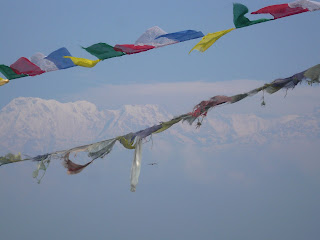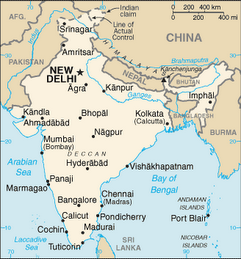
After a brief date with Indian and Nepali challenge, we were anxious to find solitude away from the traffic and polution of Kathmandu. Contrary to my expectation, Kathmandu is a sizeable city of nearly 2 million with frenetic streets, mostly unpaved. Streets are narrow, energy is friendly but high, and overall, it's not why you come to Nepal.
We booked a Ghorka Air flight from Kathmandu to Pokhara, a lakeside town huddled near the Annapurna range about 200 KM west of Kathmandu. Though we could have flown on Yeti or Buddha airlines, something about the Ghorka plane was reassuring... well, kind of. A high-wing Dornier 228 plane, roughly 18-seater, was home for a buzzing 40 minutes. The stewardess brought candies and cotton swabs for our mouths and ears respectively. I sat pinned to the window, watching the cloudy horizon and spectacular Himalayas poking through.

Pokhara is a village on a placid lake under the towering Himalayas. Untouched, forrested hills lunge into the cool blue mirror of a lake that reflects the Annapurna massif on clear sunrise. The town itself is shamelessly touristy, but this only means cheap knock-off North Face from China, Tibetan flags, and Buddhist novelties abound. There are few foreigners, typically Korean, Japanese or Chinese.
We spent two days lake-side, and one day climbing the nearby vista called Sarangkot. A taxi and climb to 5,000 feet leaves you well below the cloud line and mountains that poke through the gossamer horizon of morning moisture. From Sarangkot you can see nearly eight peaks, though their size is deceiving, as distance plays its tricky part. Fishtail, a sharp and holy peak rises above the Annapurna range, but is much shorter (~22,000 feet).
Annapurna I is the 10th highest peak in the world at 8091 meters (26,545 feet). Also in the range are Annapurna II, III, IV, Gangapurna, and Annapurna South. The sight of it rising half-way into the sky is unparalleled and magical. The crisp white of the snow blends with the clouds below, and I found I had a kink in my neck from gazing at the summit for too long with my morning chai. While October is purportedly the time to visit Nepal, we found perfection in our 70 degree days and relatively clear vistas of the world's tallest peaks.
After a night of pick-up football under the range, a japanese dinner at Koto, and a series of Everest beers, each label displaying the famous Sherpa who ascended with Sir Edmund Hillary of New Zealand, we reterned to Kathmandu for a few days of Gompas, Stupas, Temples and other sights. We saw one of the holiest Shiva temples for Hindus, and the largest Stupa in Nepal for Buddhists. We met innumerable Tibetans who had been exiled and were living in Nepal without citizenship, forced to walk a month back home as their only alternative to the official Freedom Highway back to Lhasa. We heard stories of Maoist rebels, but mainly as a protectionary force for local disputes. A boy told us how he'd incited Maoist help to save him from gang retribution, a story that smacked a bit of mafia. There are eight parties, and the country is still politically unstable according to most accounts.
Nepal is a friendly and beautiful country that is worth more than a few days visit. I hope and wait for my return to the Himalayas, or in Sanskrit, the abode of snow.












